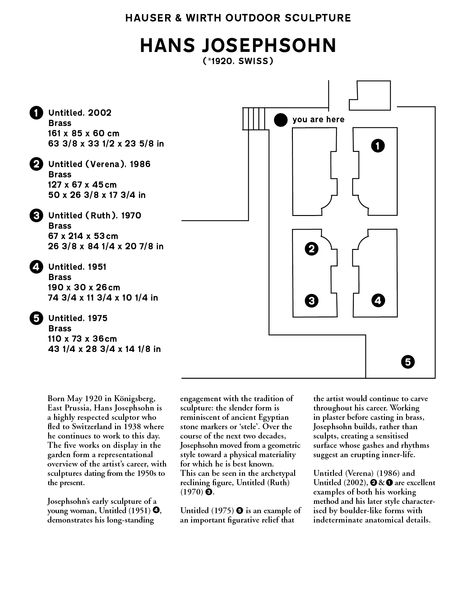
Josephsohn
28 September - 27 February 2010
Gstaad
Hauser & Wirth is delighted to inaugurate a new programme of outdoor sculpture at Southwood Garden, St James’s Church. Accessed from the courtyard in front of the church and tucked behind the gallery, the garden is a little-known oasis in the heart of Piccadilly. The first display will present works by Hans Josephsohn, whose mysterious yet profoundly human figures find particular resonance with their location. The earliest sculpture dates from 1951, just a few years after the garden was created by Viscount Southwood to commemorate the fortitude of London’s population during the war. The installation represents a welcome return to London for Josephsohn who had his first UK exhibition with the gallery in 2008. The range of sculptures on display will allow the viewer to experience the different tropes of his work. A statue of a girl from 1951 is erect and compact, her body a continuous slim volume. She will stand in the company of a half figure from 1986 and another from 2002 in which the body has been almost entirely subsumed into the head. Untitled (Ruth) (1970) is a reclining figure particularly suited to being seen outdoors. 'With reclining figures I often thought of landscape', Josephsohn has explained. In the earlier, more figurative sculptures, the contours are said to resemble mountain ridges while the naturalistic use of materials in later works lends them the appearance of forms that were born from the earth. Working in plaster before casting in brass, Josephsohn builds, rather than sculpts, creating a sensitized surface whose gashes and rhythms suggest inner life. For all the apparent roughness and approximation of their execution, each work gives off a very different personality, by turns intimate, confrontational, diffident or serenely indifferent. The exhibition also includes a high relief dating from 1975. The reliefs tell of Josephsohn’s long-standing interest in architecture and the importance he places on the relation between forms. They so impressed the architect Peter Märkli that he frequently designed houses around existing reliefs and has since built a museum to house Josephsohn’s works whose name, La Congiunta (The Marriage), expresses the extent that the art and architecture matter to one another. The outdoor Southwood Garden, backing like a courtyard against the walls of the surrounding buildings, grants a perfect situation for Josephsohn’s sculptures, providing architecture to interact with. Capable of commanding spaces with monumental authority, his works are also quiet and contemplative, speaking of man’s fragile relationship with the world in which he lives. The German-born artist has lived in Switzerland since emigrating there in 1938 in order to avoid Nazi persecution. For over 60 years Josephsohn has grappled with depicting the human image, striving to create a language for sculpture capable of summoning a person’s presence. Over time his sculptures have evolved from slender abstracted forms, reminiscent of Egyptian stele, to vast boulder-like half figures, craggy and indeterminate, seemingly buried in their own bulk. In diametric opposition to Giacometti, to whom he is often compared, Josephsohn achieves poignancy in heft, allowing the agitated exteriors and off-kilter poises of his massive beings to convey sensitivity and vulnerability. Above all, they appear stoic: 'they must be enduring in their expression, in their stance' Josephsohn has said, and the tentative permanence of his figures at once convey timelessness and the encounter of a particular moment. Josephsohn was born in 1920 to a prosperous Jewish family in Königsberg (Kaliningrad), then in East Prussia. He travelled to Florence in 1938 to study sculpture then emigrated to Switzerland in the wake of fascist laws. He has lived and worked in Zürich ever since. There are two permanent installations of his work open to the public: Kesselhaus Josephsohn, an exhibition space and foundry outside St. Gallen, Switzerland; and La Congiunta, a small museum in the Southern Swiss Alps designed by the architect Peter Märkli, to whom the artist has been a longstanding key influence. Hauser & Wirth London presented a solo exhibition of Josephsohn’s sculpture in 2008. Major exhibitions of his work include retrospectives at the Stedelijk Museum, Amsterdam (2002) and the Frankfurt Museum of Modern Art (2008). From mid-November 2009 his work can also be seen in a group show at Parasol Unit, London, 'Visible Invisible', showcasing work on the edge between figuration and abstraction. For further information and artwork material, please contact: Catherine Mason at Calum Sutton PR: +44 (0)20 7183 3577, catherine@suttonpr.com or HAUSER & WIRTH LONDON: +44 (0)20 7399 9789, press@hauserwirth.com www.hauserwirth.com HOURS: daily 10 am – 6 pm
Installation views


Current Exhibitions
1 / 12

















